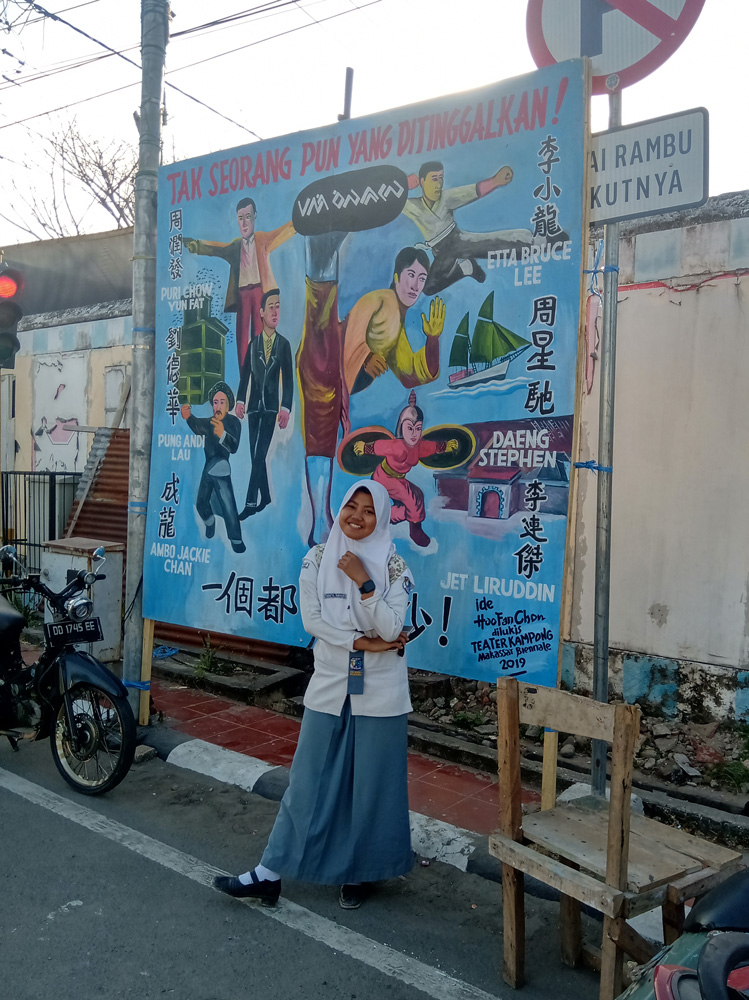Tak Seorang Pun Yang Ditinggalkan












These works were made during a residency in Bulukumba regency as part of the programme for Makassar Biennale 2019 “Maritime: Migration - River - Culinary” (chapter Bulukumba).
Premiered on 2019 Sept 16 Tarungku Toae (Roemah Penjara), a 19th century dutch-build prison in Bulukumba which used to house the local community theatrical troupe "Teater Kampong" (IG @teaterkampong_)
Project manager: Anitha Silvia
Tak Seorang Pun Yang Ditinggalkan
Single channel Mpeg-4 video, 12.44 min, 2019
Voice talents:
Anjar, Masiga, Boim, Feli, Gatot, Indah Andira, Mage’, NDR, Siddiq Fathanah, Tinta & Valent
Movie clips sourced from YouTube.
Traditional Bugis folk song Anging Mammiri, performed by the Kampong band
Tak Seorang Pun Yang Ditinggalkan (movie poster)
Wall paint on plyboards, 244 x 244 cm, 2019 (drafted by Hoo Fan Chon & painted by Teater Kampong community)
Premiered on 2019 Sept 16 Tarungku Toae (Roemah Penjara), a 19th century dutch-build prison in Bulukumba which used to house the local community theatrical troupe "Teater Kampong" (IG @teaterkampong_)
Project manager: Anitha Silvia
︎
List of works:Tak Seorang Pun Yang Ditinggalkan
Single channel Mpeg-4 video, 12.44 min, 2019
Voice talents:
Anjar, Masiga, Boim, Feli, Gatot, Indah Andira, Mage’, NDR, Siddiq Fathanah, Tinta & Valent
Movie clips sourced from YouTube.
Traditional Bugis folk song Anging Mammiri, performed by the Kampong band
Tak Seorang Pun Yang Ditinggalkan (movie poster)
Wall paint on plyboards, 244 x 244 cm, 2019 (drafted by Hoo Fan Chon & painted by Teater Kampong community)
The slogan “Put Bahasa Indonesia First” appears on the omnipresent government-sponsored billboards in Bulukumba, where most of the locals speak Bahasa Bugis, including members of its Chinese Peranakan community. This video work’s title is derived from a Bugis axiom, "Mali' Siparappe", which denotes the communal spirit of keeping an eye out for each other so that no one is left behind. Most foreign movies broadcasted on Indonesia’s cable television channels are dubbed into Bahasa Indonesia. Many international Chinese film stars have become household names among Indonesians, especially those working in the martial arts, action and comedy genres. But few local stations feature foreign films in their respective local languages, despite how approximately 300 languages are spoken daily in Indonesia. This collaborative dubbing project invited members of the local community to voice over some scenes from popular Chinese films. A few popular Chinese movie scenes were compiled, with their scripts predominantly translated into Bahasa Bugis and performed by local non-professional voice actors. This process required voice actors to imagine their subject’s unfamiliar cultural milieu in a fictional setting, while using their local language to internalise this “foreign” culture as a way of celebrating their love for popular Chinese cinema.